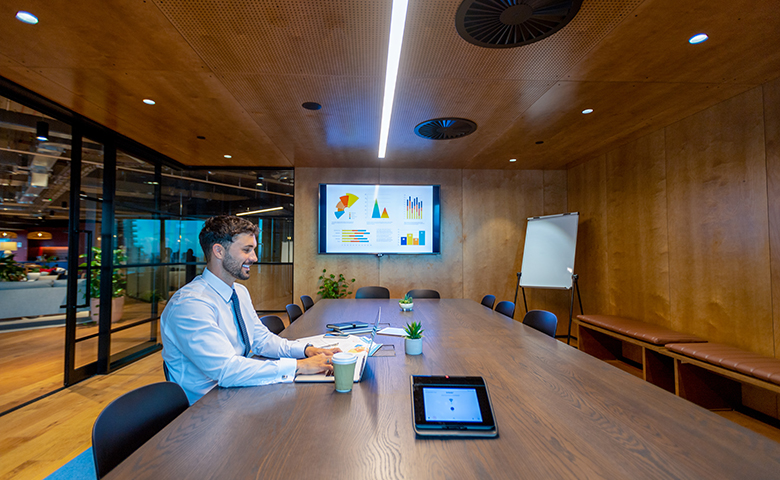We often hear that there isn’t enough communication throughout the company and at the same time also hear that there are far too many emails. Too many emails make it hard for people to read or retain the information being sent. Signs or posters around the building can provide an attention-getting alternative but placement and the fact that they’re static cause people to become blind to them.
If a TV is turned on in the workplace, how many people do you think will watch it?
This form of communication is an effective method of engaging employees and making them feel like they’re part of the organization. From a safety standpoint, this is also a great way to reinforce safety training by displaying the message in an aesthetically pleasing way.
People will often notice TV displays in the workplace as they pass by them, and if the screen is displaying compelling content then it will catch their eye and cause them to pause. Similar to a toolbox talk, these presentations can deliver a familiar message but unlike toolbox talks, there’s typically no audio component to these presentations so extra attention needs to be paid to the visuals, text, animations and timing to ensure the message is delivered well.
It’s important to change the TV display presentations every month to avoid habituation and sprinkle in some pertinent company information at the end to keep employees engaged (e.g., upcoming fundraiser details or company events). We have a great resource of toolbox talk topics that can help in developing your presentations by month, but here are a couple of other ideas for February to get the ball rolling.
You could dig deeper into the topic of winter hazards off-the-job safety, and if you haven’t delivered a toolbox talk on the topic yet, this is the perfect opportunity to develop a digital presentation. Weather and its impact on people and the surrounding area is a great option for internal communication presentations during February as it lets you provide safety tips for both on and off the job. For example, in the workplace, you could recommend employees practice taking small steps in the parking lot if the temperature drops and there’s a potential for ice. You can also communicate safety expectations in the winter. If the first person in the building is expected to salt the walkways, use the TV display to remind employees about the location of the salt and the expectation to use it.
At SafeStart, we leave umbrellas at the door for rainy days so people don’t have to rush to avoid getting soaked. This allows them to keep their eyes and minds on the task of safely navigating the parking lot so they will be less likely to make the error of jogging out in front of a moving vehicle in haste. A digital display is a great way to remind staff about the purpose of those umbrellas at the door by stating something simple yet important and practical: “When the rain is gushing, you’ll find yourself rushing (to your car). Please use an umbrella to avoid losing your balance or moving into the line of fire in the parking lot.” Plus, the instruction to return the umbrella the next day when the employee is finished using it reinforces a culture of looking out for their colleagues where everyone has the opportunity to borrow umbrellas and stay safe.
Other weather-related presentations could include tips on staying safe if you need to be outside in the cold weather, knowing the signs of hypothermia and frostbite, and providing prevention tips to avoid weather-related incidents. Researching stats is a great way to get people’s attention on this type of communication. Even basic reminders can be helpful, such as:
-
Hypothermia can happen in temperatures as high as 50°F
-
Red and painful skin can be a sign of frostbite.
Numbered lists of prevention tips can make for great slides. But try not to overload your slides with too much information. Add images and limit the text on the screen to make sure it is eye-catching and effective.
Due to the increased use of heating equipment and appliances, the risk of fires and carbon monoxide poisoning are other timely February safety topics. There are several options for digital displays and presentations. For example, you could do an entire presentation on carbon monoxide poisoning to educate workers about the risks on and off the job. Another topic that often resonates with workers is emergency planning and the importance of smoke alarm testing. Preventive maintenance in the home is also a relevant subject, and you could note issues like keeping chimneys and exhaust vents free from debris, ice, and snow accumulation to reduce the risk of carbon monoxide (CO) build-up. It’s also important to have chimneys and fuel-burning appliances inspected by a professional at least annually to prevent fire.
These topics might seem like common sense, but you’d be amazed at how often a reminder of things “people should already know” helps to bring their minds to the tasks they’re performing. When you get into a routine, it’s easy to go on autopilot and forget about all of the associated risks. Make sure that you’re communicating regularly to your employees and in various types of formats—and digital displays are a great way to help you do so.

